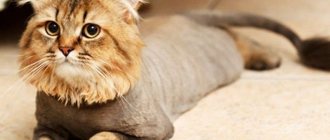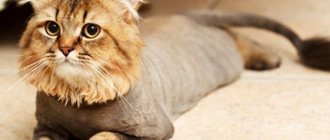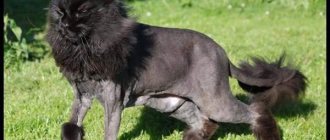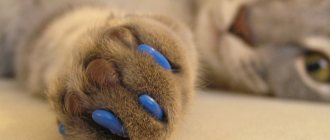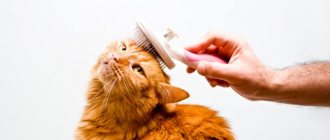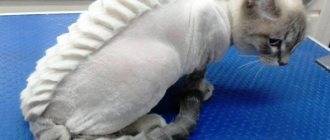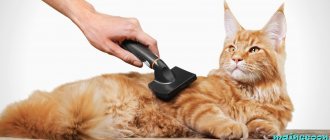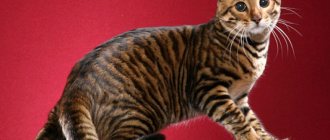Cats are very clean animals, and they usually take great care of their own hygiene. However, there are times when an animal needs human help. If for some reason a cat cannot take care of itself, or it definitely needs a haircut, the owner can seek the services of a groomer. Let's consider what grooming is, why it is needed, its pros and cons.
What is grooming
For many, the word grooming is strongly associated with cutting an animal. Actually this is not true. Grooming is a set of measures for caring for the skin and fur of an animal; it also includes caring for the cleanliness of the cat’s eyes, ears, teeth and claws. These procedures can be carried out by a specially trained person in a special salon, or the owner himself can do them.
Cats are quite clean, and therefore they do not need much special care. They rarely get haircuts; often they are needed only by certain groups, or according to indications. Most often, owners of animals who participate in exhibitions turn to the services of groomers. In this case, the pet is scheduled to see a specialist in advance. It should look perfect for the exhibition. The owner can deal with the departure of an ordinary pet on his own. The main thing is to accustom your pet to hygiene procedures from childhood.
If the owner himself cannot cope with grooming, but also does not want to worry the pet too much, a groomer can be called to the house. In a familiar environment, it will be much easier for the cat to endure all the procedures. In addition, there will be no unnecessary stress due to visiting unfamiliar places.
How to trim your cat's hair at home
There are two main reasons why owners refuse the services of professional groomers and learn to trim cats themselves:
- Saving money and time.
- Caring for the psychological state of the pet.
Most cats feel more comfortable and calmer in their familiar home environment and trust more the manipulations that their beloved owner performs with them. For those who are not afraid and are ready to master the art of grooming, here are our useful tips on cat grooming.
What you need to groom a cat
Think about where it will be more convenient for you to groom your pet. Some owners prefer to do this in the bathroom to make it easier to clean up the cut wool. If you choose to mow in a room, remove carpeting from the floors. Make sure there is a flat surface (table) on which you will cut your hair. Place an old towel on the table.
Before you begin the process, purchase:
- medium-sized animal clipping scissors with sharp blades and rounded ends;
- a special machine for grooming cats.
You may also need:
- a sparse comb and brush to comb out the coat before cutting;
- a fine comb - to carefully cut out tangled areas and tangles, placing it between the animal’s skin and the clipper;
- hydrogen peroxide for treating occasional wounds.
Tips for grooming cats at home
- Select the place where the haircut procedure will take place, prepare the work surface.
- Start by trimming the nails - this way you will protect yourself from your pet’s aggression and possible injuries.
- It is more convenient to groom a cat at home with two people - ask one of the household members to help you. Let him hold the cat's sides and limbs while you work.
- If the cat is too aggressive, put an Elizabethan collar on the animal.
- Before you start grooming, talk gently to your pet, offer him a treat or a favorite toy, and gently comb him with your favorite comb.
- Act confidently, but carefully - the cat may feel the owner’s excitement and will become worried.
- The haircut starts from the back and sides. After this, carefully move to the abdominal area. The limbs and tail are usually left untouched at home.
- The area around the mammary glands is carefully processed with scissors, pulling off the hair and placing a fine-toothed comb.
- If you are using scissors, lightly dampen the wool. Only dry wool can be cut with a clipper.
- If you want to leave longer hair, work in the direction of hair growth. For a shorter haircut, shave against the direction of hair growth.
- During the cutting process, clean the clipper blades from hair.
- After grooming, bathe your pet with a mild detergent and dry the cat dry.
Don't forget to treat your cat with something tasty when you finish the grooming procedure.
Important!
If your cat is not in the mood for a haircut, breaks free and runs away from you, do not chase the poor animal - this is stressful for him! Postpone the haircut and try again in a few days.
Can tools be used to cut a person's hair?
Professional groomers answer this question - absolutely not! Let's explain why. Yes, hairdressing scissors and hair clippers for humans are no different in appearance from the same devices for grooming pets.
But the structure of wool and human hair is very different. Wool is much softer. In addition, cats have an undercoat (downy hair). The blades of human instruments are not designed for this. If a cat owner's clipper is used to groom a pet, it will quickly overheat and the blades will quickly become dull. Dull blades do not cut, but “jerk” – this causes discomfort and pain to the animal.
Therefore, if you decide to cut your cat’s hair yourself, do not spare money and do not torture your pet - purchase special devices for grooming animals.
Important!
The only thing you can use a regular clipper for is to remove a single mat from a short-haired cat.
Video:
A set of grooming activities
Animal care procedures can be carried out both at home and in a special salon. The first option is more acceptable, since the animal experiences less stress during the procedures. However, the salon has a lot more special tools and equipment that you can’t always take home with you.
The set of grooming activities includes the following activities:
- ear cleaning;
- rubbing the eyes (in some breeds with very watery eyes, this procedure must be carried out regularly);
- teeth cleaning (carried out using special paste and brush);
- maintaining the optimal length of the claws (a special nail clipper is used to shorten the claws);
- bathing the animal;
- a haircut.
Where is it better to cut a cat's hair - in a salon or at home?
Whether you take your pet to a professional groomer or cut it yourself is up to you. We will look at the pros and cons of both options, and tell you what points you need to pay attention to.
Cat grooming in professional grooming salons
Let's start with the fact that during grooming in a salon, a specialist examines the cat and assesses the condition of its fur. The groomer can give recommendations on coat care, recommend cosmetics and vitamins for the skin and coat. The entire process takes place in a specially equipped place, which is also one of the advantages of this option.
The disadvantages include the high cost of a professional haircut and the stress that the cat experiences when it is taken to the salon. In order not to expose the animal to unnecessary stress, you can invite a specialist to your home.
Haircut under anesthesia
Some owners want to reduce discomfort for the cat and protect themselves and the groomer from cat revenge. To do this, they resort to anesthesia. There are also inexperienced groomers who are not very good at handling cats.
When grooming cats, injections of muscle relaxants are used as anesthesia. Under the influence of these drugs, the cat becomes immobilized, but does not lose consciousness.
Advantages of haircuts under anesthesia:
- the animal does not interfere with the process;
- no need to hold the animal, trim its claws, bandage its paws, or put on an Elizabethan collar;
- there is no risk that the animal will injure itself, its owners or the groomer;
- the groomer does his job faster.
Disadvantages of cutting hair under anesthesia:
- the animal does not lose consciousness, hears and sees everything, experiences panic at this moment;
- the injection and the haircut itself should be done by a specialist with veterinary or medical education;
- It is imperative to weigh yourself before anesthesia to calculate the appropriate dosage of the drug;
- It is advisable to first be examined by a veterinarian and have a cardiogram done;
- if the dosage of anesthesia is exceeded, paralysis of the diaphragm and intercostal muscles occurs - breathing difficulties arise, cardiac arrest is possible;
- To recover from anesthesia quickly and safely for the pet’s health, it is necessary to give another injection, otherwise the cat will recover from anesthesia within 24 hours;
- If you give a cat a haircut several times under anesthesia, haircuts without anesthesia will be unavailable to her - the animal remembers its panic and sensations and closely associates them with the grooming process.
Video:
Haircut without anesthesia
Grooming without the use of medications is considered less dangerous for the animal, since anesthesia is always a risk, the result of which cannot be programmed.
Advantages of haircut without anesthesia:
- the animal is fully conscious and does not lose mobility - it feels more confident;
- an experienced groomer knows how to approach a cat and calm it down without violence;
- there is no risk of side effects of muscle relaxants;
- the animal trusts the specialist more;
- The cat quickly gets used to the procedure and learns to tolerate it calmly.
Disadvantages of cutting hair without anesthesia:
- may take longer;
- in some cases, additional fixation of the animal and the use of a veterinary collar are necessary;
- There is a risk of a person being injured by a cat.
Video:
Required Tools
To groom a cat you will need the following tools:
- long-toothed comb;
- a slicker brush is needed to comb out all the fallen hair;
- nail clipper;
- cotton pads and sticks;
- special toothbrush and toothpaste;
- antiseptics in case the animal gets injured during hygiene procedures;
- scissors;
- trimmer.
It is not recommended to cut tangles with scissors. It is very easy to injure an animal this way. And trying to untangle them is also not a good idea. Due to the special structure of wool, this is impossible. A trimmer is best for removing tangles.
You should not use any human products when caring for your cat. Toothpaste has too strong a smell and can cause irritation, and human shampoo is not suitable for a cat. A human toothbrush has too hard bristles. If there are no other options, you can use a brush for very young children. It is better to purchase all other products at a veterinary store in the cat products section. .
Is it possible to sharpen knives yourself?
It is almost impossible to sharpen knives in the device yourself.
Only a specialist knows the roughness class of the working surface and the direction of the marks on it.
After sharpening, the master must dull the side edges so that you do not cut yourself during the procedure.
When sharpening, it is imperative to maintain a perfectly flat working surface of the knife.
The marks must be strictly parallel to the side edges, or at a slight angle.
The main thing is that the working surface is not mirror-like - this will lead to the knives sticking together during operation.
To summarize, we see that sharpening a cat clipper yourself can be done incorrectly, which will ruin it.
In addition, the craftsmen carry out sharpening using professional equipment, guaranteeing the quality and reliability of the work performed.
Types of grooming
Depending on the goals pursued by the owner, the following types of grooming can be distinguished:
- Hygienic. The animal is bathed, its eyes and ears are cleaned, its claws are trimmed, and its teeth are brushed. The wool is cut in the groin area and on the stomach so that it does not get dirty so much. Trim the hairs between the pads and fingers.
- Home. This type includes all the procedures that the owner carries out with his pet at home: combing the fur, trimming the claws, cleaning the eyes and ears, bathing. In addition, the owner can cut off the tangles formed on the cat’s fur himself.
- Exhibition. Although it is not recommended to bathe cats frequently, they are thoroughly cleaned before exhibitions. In addition, the cat can be given a neat haircut, which is necessary to emphasize all the advantages of this animal and give the coat a neat appearance.
- Creative. Cats are given rather unusual hairstyles, cutting out entire patterns and giving their fur an unusual look. It is not advisable to do this for “beauty”, but if the animal needs a haircut in any case, then its fur can be given an unusual shape.
We recommend the article: Traveling with a cat: important tips for trips and trips
Cat grooming prices:
| Animal | Washing/drying | Haircut/shaving | Washing+combing | Claws |
| cat | 1500 rub. | 2000-2500 rub. | 3000-3500 rub. | 300 rub. |
| Maine Coon | 2500 rub. | 2500-3500 rub. | 3500-4500 rub. | 300 rub. |
See the full price list for cat and dog grooming and additional services here >>
Note! Grooming salon "ARTEMONoff" is located near the Belomorskaya metro station, on the territory of the Northern Administrative District of Moscow (Levoberezhny and Khovrino districts). Residents of Dolgoprudny, Tushino, Khimki also get there quickly and conveniently.
Necessity of grooming
There are cats that cannot cope with their own hygiene. There may be several reasons for this:
- elderly age;
- excess weight;
- health problems;
- hormonal surges during the period of sexual hunting.
And completely healthy animals require the care of their owner. It is not advisable to frequently bathe a healthy animal, since it is often a lot of stress for the cat, and frequent exposure to chemicals can lead to skin irritations. The cat is bathed if there is any contamination, before shows and as indicated by the veterinarian. If you need to apply a special product to your skin. In this case, you should make sure that the animal does not freeze or catch a cold after bathing. If the cat experiences very strong stress from contact with water. You should avoid swimming altogether. Dirt can be removed using wet wipes.
Some breeds are prone to having very watery eyes. Therefore, they must be periodically wiped with a clean cotton pad moistened with boiled water. It is necessary to periodically inspect your pet's ears and remove dirt from them with a cotton swab.
Veterinarians strongly do not recommend surgery to completely remove the claws. But you can trim them periodically. Especially if the animal does not actively use the scratching post. When trimming nails, be careful as blood vessels can easily be damaged. Just in case, you should prepare an antiseptic and cotton pads.
Owners rarely bother with brushing their pet’s teeth. As almost all cats age, they develop tartar, which can lead to gum disease. That is why this procedure should not be neglected. You should be accustomed to brushing your teeth from childhood, this is the only way your pet will normally accept this not very pleasant procedure.
Cats, especially those with long hair, need to be brushed regularly. To do this, you can use special combs that will help remove lost hair and slicker brushes. This way the pet will look neater, and it won’t swallow so much fur while licking. In addition, there will be much less hair on the furniture. During the shedding period, it is advisable to comb your pet every day.
Grooming cats is an issue that causes a lot of controversy. Many veterinarians and breeders advise cutting an animal's hair only when absolutely necessary. This is due to the fact that the event itself can cause considerable stress in the animal. Short haircuts can lead to disruption of heat exchange, and the undercoat may never fully recover. In addition, many cats undergo haircuts under anesthesia, which has a very bad effect on the health of the animal.
There are some breeds whose special coat structure leads to the formation of tangles. Theoretically, this problem can be solved by combing the animal every day. However, even this does not always help. Mats easily absorb dirt and can emit an unpleasant odor, irritation can form on the skin underneath them, and the cat can also swallow the mat while licking, which can lead to intestinal blockage.
We recommend the article: Proper care of a furry pet: where to start?
Grooming of cats is also recommended for the following reasons:
- The animal is very hot, and this problem cannot be solved by other methods. If it is impossible to reduce the temperature in the room, then haircuts are used for long-haired animals.
- The animal will undergo medical procedures or surgery. In this case, the wool is clipped only in the right places.
- The animal has a skin disease, for the treatment of which it is necessary to cut the hair. In this case, the procedure is carried out in a veterinary clinic.
- The cat swallows too much hair. This often happens in long-haired breeds. Often the hair itself easily comes out of the body, but in some cases this does not happen.
- The animal needs to be combed very often, and in extreme cases, trimmed.
When not to cut your cat's hair:
- The animal has serious skin problems.
- The cat experiences a lot of stress during the grooming process.
- If the house is cold. The animal will begin to freeze and may catch a cold.
- The cat has serious health problems, for which unnecessary worries are contraindicated.
Even if you really want to give an animal a fashionable and unusual hairstyle purely for aesthetic reasons, this idea should be abandoned. First of all, you need to be guided by the interests of your pet, and not by your own desires.
Why do cats get their hair cut?
There are two main blocks of reasons why owners cut their pets' hair:
- Hygienic – for health and well-groomed appearance.
- Aesthetic – for beauty.
Hygienic cat grooming
This is rather a necessity - this haircut is most often done on long-haired and fluffy cat breeds.
Why give your cat a hygienic haircut?
- to normalize the thermoregulation of the cat’s body - long and thick hair, especially in the summer, contributes to severe overheating of the animal;
- to help sick and elderly animals who do not care enough for their fur - haircuts save cats from matted and very matted fur;
- to rid the cat of pellets and tangles - matted fur tightens the skin, impairs blood circulation, causes itchy skin and discomfort in the cat;
- hygienic hair cutting is indicated for some skin and parasitic diseases;
- in case of increased secretion of glands, including paraanal glands, it is recommended to trim the area around the genitals;
- for long-haired breeds, the area of the “panties” and under the tail is trimmed to prevent excrement from sticking;
- trimming helps reduce the number of bezoars – hairballs that form in the cat’s gastrointestinal tract;
- cats with prolonged and heavy shedding are clipped to keep the house clean;
- before performing medical procedures on the skin;
- Long-haired cats are clipped if their fur becomes very matted.
Aesthetic cat grooming
This block of reasons includes those that are not a necessity for the animal. This is rather a whim of the owner, a desire to stand out.
Why do aesthetic cat grooming?
- before exhibitions and competitions in which there is a nomination for “Best Haircut”;
- before a photo shoot of an animal to get unusual pictures for Instagram;
- cats with interesting body patterns have their fur trimmed along the line of the pattern to emphasize the natural pattern;
- Extravagant cat owners give their pets fashionable haircuts to match their owner's image.
Important!
If your cat doesn't have a particular need for grooming, leave it alone. Do not interfere with wool to perform its protective functions.
Pet behavior
Most hygiene procedures can become a real stress for a cat if it has not been accustomed to them since childhood. Therefore, from the first months the kitten needs to be accustomed to grooming procedures. You need to periodically comb him, trim his nails, clean his eyes and ears.
All this should be done carefully, without using force, otherwise the pet will be afraid of these procedures in the future. If you behave correctly with the animal, over time it will get used to it and will be patient with all manipulations.
If the animal is very nervous during the grooming process, you should not do anything by force. You cannot use force, and even more so you should refuse to use anesthesia. Some salons use it. Of course, in a dream the animal does not see or feel anything, and therefore does not stress during the haircut. However, anesthesia negatively affects the health of the animal. If the cat had hidden pathologies, it may not wake up at all.
Before grooming, it is advisable to trim your cat's claws. If she suddenly gets scared and starts to struggle, this will help avoid injury. It should also be noted that haircutting is a very long procedure that can take up to several hours. Not every animal, even the calmest one, can endure this. Therefore, it is desirable for the owner to be nearby. He will be able to distract and calm the pet if necessary.
Device power type
The choice of machine is not limited by the difference in operating principles; the type of power supply is also important. There are networked, battery-powered models and combined-type devices that are powered by an outlet or batteries.
Battery models are very mobile and relatively independent from the network. The power source is a built-in or removable battery, or regular batteries. The disadvantage of a wireless device is that the time of continuous use is limited by the battery capacity, on average from 1 to 1.5 hours.
Hair clipper ZIVER-209 (battery-mains)
The power of such a device is reduced when the charge level is less than 30%.
It is logical that such a device is capable of trimming a large animal only if it has several replaceable batteries. It is possible to carry out a haircut in several stages, but this is not very convenient.
Mains power provides constant power, which reduces the overall cutting time compared to battery-powered clippers. The devices are characterized by stable, but noisier operation.
Andis AGC-2 Speed – professional animal clipper
Combined devices are universal and are in great demand, despite their relatively high cost.
WAHL machine (USA) with Super Groom combined food
Popular haircuts
Most often, animals are given hygienic and exhibition haircuts. The first is important for maintaining the animal's hygiene, and can even be done at home. The second is done by a specialist. It is designed to hide all the shortcomings of the animal’s exterior and emphasize its advantages.
When grooming a cat, the groomer adheres to the following rules:
- The hair on the head is not touched, since without it it becomes more difficult for the animal to navigate in space.
- Do not touch the hair in the ears, as it protects them from dirt.
- You cannot cut an animal bald; you still need to leave at least a small amount of fur. Without it, the animal will begin to freeze, and direct exposure to sunlight on bare skin can lead to burns.
We recommend the article: Grooming cats: the pros and cons of the procedure
If, for certain reasons, the animal needs a more serious haircut, it can be done creatively. Just don’t try to do this haircut yourself at home. At best, you can simply ruin the appearance of your pet. In the worst case, you could damage his skin. Short haircuts are best left to the experts.
Dragon A cat's back ridge is cut out in steps or a kind of mohawk is made, while the rest of the body, except for the head and paws, is cut very short. The cat visually begins to resemble a baby dragon. Lion Leaves quite a lot of fur on the head, neck and chest, making it resemble a lion's mane. A fluffy brush is left at the tip of the tail.
Puma Only the back part of the body is cut short. The chest, head, and paws remain intact. This haircut is good if the animal is hot to normalize thermoregulation.
What to consider if you decide to trim your cat
- Grooming is stressful for the animal, so it is best to refuse it unless there are clear indications (state of health, coat or exhibition).
- If necessary, ask the groomer about the possibility of sedation (use of anesthesia). Don't forget to check this with your veterinarian first and inquire about the groomer's medical background.
- It is best if a specialist from a grooming salon comes to trim your pet at home. This is especially important if the cat is nervous and does not like the grooming procedure. A familiar home environment has a calming effect on your pet.
- In some cats, after clipping, the coat may change color and texture, for example, becoming darker and thinner. Keep this in mind and do not cut cats with color point and tipping colors.
- There are cases when an animal’s fur takes a very long time to grow back to its full length or does not grow back at all. Possible sudden color change.
- It is not recommended to cut the hair on the animal's head, whiskers and eyebrows - this can damage the whiskers.
- You cannot completely cut the hair from the tail - leave the hair at ⅓ of the length. Cats love to chew their tail, thereby causing wounds to themselves.
- In the area of the fingers and lower joint of the limbs, you need to leave “socks” made of wool. Their length may vary.
- Before grooming, a cat needs to trim its claws to avoid wounds and scratches not only for the owners and groomer, but also for the pet itself.
- The frequency of haircuts depends on the condition of the coat and the health of your pet; usually cats are cut 2-3 times a year.
- The ideal nozzle for a clipper used to cut a cat’s hair is 3 mm. When using it, the trimmed fur will be soft and will not cause discomfort to the cat. If you use a 1 mm nozzle, the fur will be prickly for the first week - pets don’t like this.
- It is unacceptable to shave cats' heads. They have very delicate skin. A hairless cat can injure itself simply by scratching itself. Animals that go outside can get sunburned.
- It is not recommended to remove tangles with scissors - this can injure the skin. To prevent this from happening, they cut it with a clipper or use a fine-tooth comb (comb) under the tangle, and only then carefully cut it off.
- Exhibition animals are allowed to be groomed 3-6 months before the exhibition.
Positive points
- Yes, a haircut makes life easier for a long-haired pet: it is easier for a cat to lick itself and wash its coat. In this case, the animal will not clog its stomach with swallowed wool.
- This means that hair removal paste is not needed and the family budget will not suffer.
- In summer, the animal suffers less from the heat, and in the winter months, apartment heating will warm the cat, no matter how short its hair is cut. The main thing is that there are no drafts in the rooms.
- The absence of fur on most of the purr's body gives owners rest. There is no need to comb your pet or fight fluffy debris in the apartment. After all, before the haircut, cat fluff flew around the house like poplar.
- No wool - no allergies. This is also an important aspect of the issue, especially for family allergy sufferers. You can safely continue to communicate with your four-legged family pet.
How to prepare for a haircut
Before starting the procedure, choose a place for it - a spacious, flat surface. It is best to use a kitchen table. Remove all unnecessary items from it.
Enlist the help of an assistant. It is difficult to carry out the procedure alone, since it is quite lengthy. Stock up on treats for your pet.
Prepare the necessary tools:
- Trimmer for hard-to-reach and intimate areas.
- Scissors with blunt ends or a tangle cutter.
- Thinning scissors.
- A clipper (if the cat has long hair, you need a powerful electric clipper, at least 45 W).
I also recommend preparing the following materials:
- a thick towel to wipe the cat;
- a disposable diaper in case of an unexpected bowel movement;
- gloves for yourself and your assistant;
- thin comb and brush for combing;
- softening conditioner for combing;
- lubricant for the machine.
